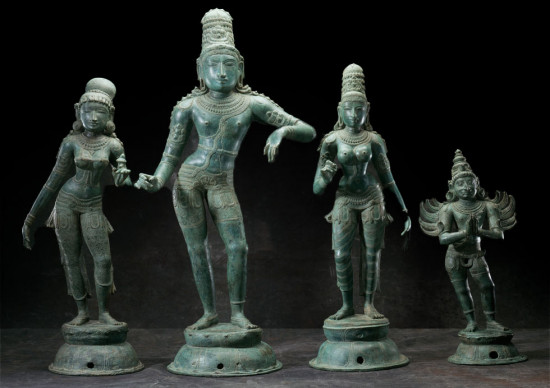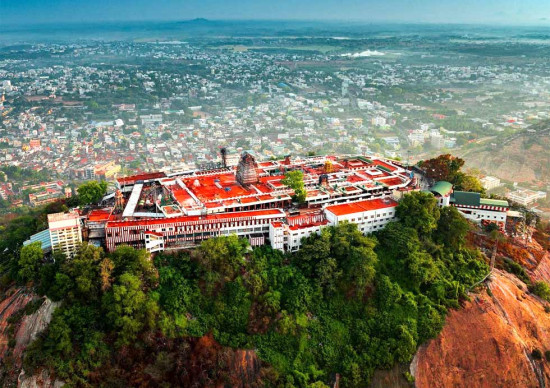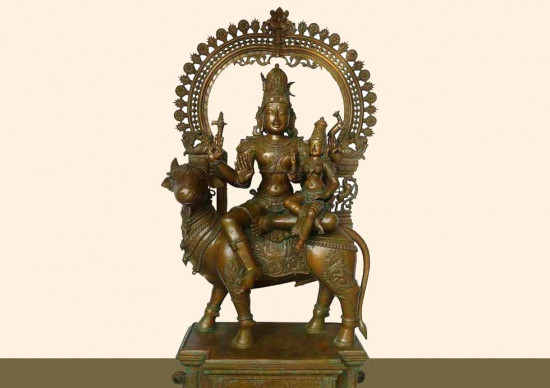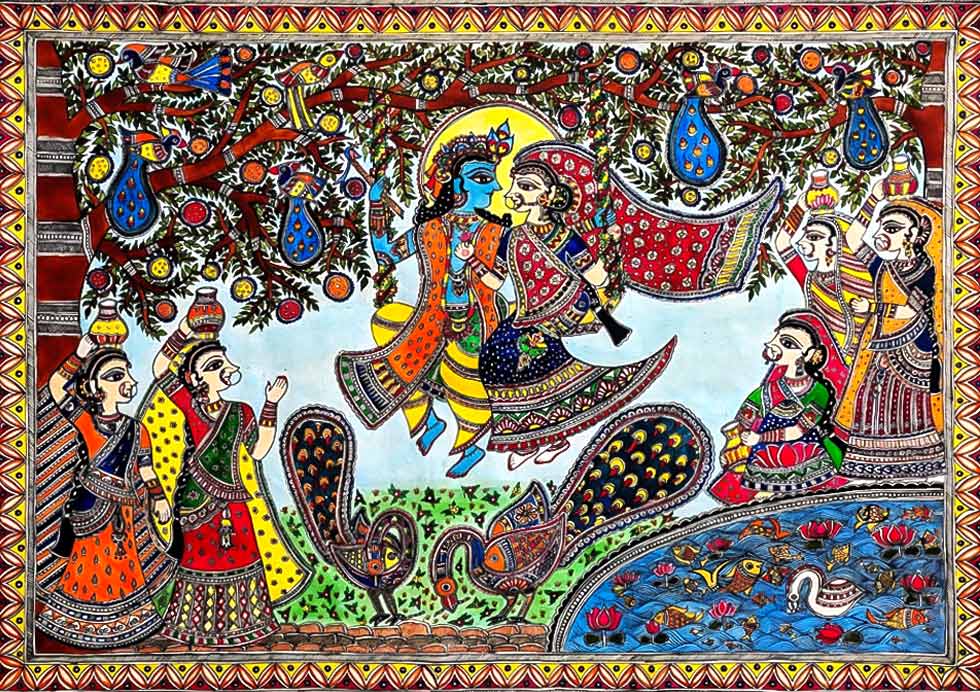
Madhubani Paintings
The origins of Madhubani painting are often attributed to the epic times of Ramayana, where it is believed that King Janaka, Sita's father, ordered his kingdom to decorate the walls of his palace with intricate paintings to celebrate her marriage to Lord Rama. Over time, this artistic tradition evolved and expanded beyond palace walls, becoming a cherished practice among women in Mithila. It was traditionally passed down through generations, with motifs and techniques handed down from mothers to daughters.
Initially, Madhubani art served as a form of decorative expression during festivals, weddings, and other auspicious occasions, adorning walls, floors, and ceremonial objects. The paintings were characterized by bold lines, vibrant colors derived from natural pigments, and intricate patterns depicting mythological themes, local flora and fauna, religious motifs, and scenes from daily life.
In the mid-20th century, Madhubani painting gained international recognition when artists like Sita Devi and Jagdamba Devi brought it to the forefront through exhibitions and commissions. These efforts helped transform the traditional folk art into a recognized form of contemporary Indian art, celebrated for its cultural depth, intricate craftsmanship, and vibrant visual appeal.
Today, Madhubani painting continues to thrive as a cherished art form, evolving with modern influences while preserving its cultural authenticity. It serves as both a means of artistic expression and a cultural ambassador, embodying the spirit, stories, and traditions of the Mithila region for generations to come. Radha and Krishna are prominently portrayed in Madhubani paintings primarily because they hold a special place in Hindu mythology and cultural traditions.
A Love Story Woven in Threads: Radha and Krishna in Mythology
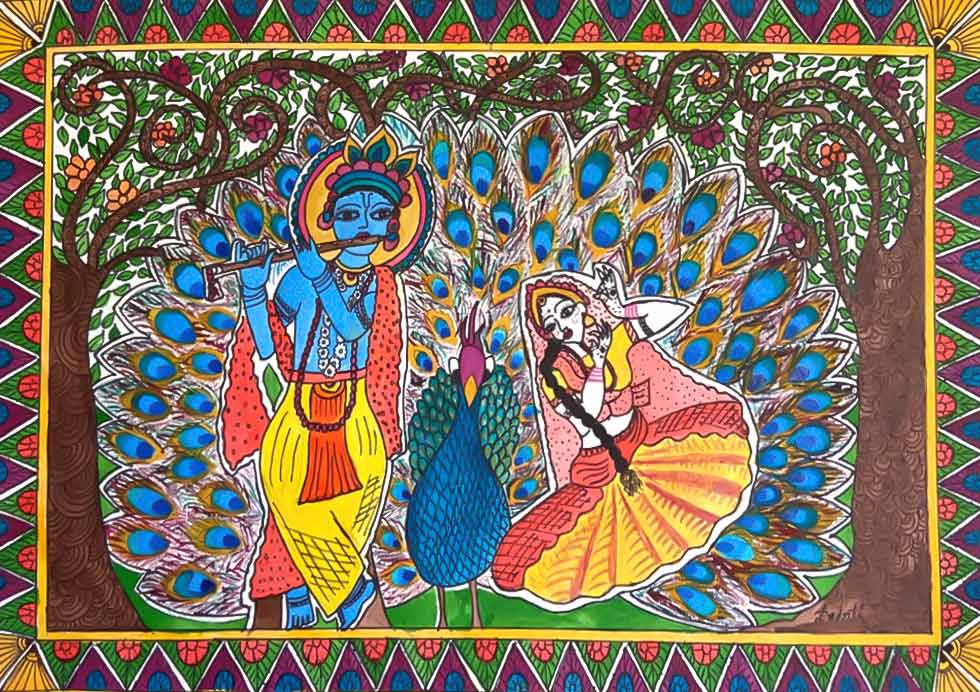
Madhubani paintings capture the essence of this love story in a multitude of ways. Often, they depict scenes of Radha and Krishna frolicking in the Vrindavan forests, playing the flute, or sharing tender glances. The vibrant colors and intricate details breathe life into these scenes, transporting viewers to a world of divine romance.
Beyond their mythological significance, Radha and Krishna offer artists a rich canvas to explore themes of love, devotion, and spirituality. Madhubani paintings thus not only serve as decorative art but also as mediums for spiritual expression and storytelling.
Symbolism: A Language Beyond Words
Madhubani paintings are not merely visual representations; they are a language rich in symbolism. Each element within the artwork holds a deeper meaning, offering a window into the beliefs and traditions of the Mithila region. In Madhubani art, Radha and Krishna are depicted with symbolic elements that enrich their portrayal. For example, Krishna is often shown with a peacock feather or playing the flute, symbolizing his divine attributes and charismatic presence. Radha is portrayed with floral motifs and surrounded by nature, symbolizing her beauty and connection to the divine.
- Lotus Flower: A symbol of purity, enlightenment, and spiritual awakening, the lotus flower is often depicted at the feet of Radha and Krishna.
- Peacock: Representing beauty, pride, and rejuvenation, the peacock feather is frequently incorporated into Krishna's attire.
- Mango Tree: Signifying fertility, abundance, and prosperity, the mango tree is often depicted as a backdrop to Radha and Krishna's interactions.
- Fish: Symbolic of fertility, abundance, and marital bliss, fish motifs are sometimes incorporated into the Madhubani border.
Artistic Techniques: A Legacy Passed Down Through Generations
Madhubani paintings are traditionally created using natural elements. Artists use vibrant dyes extracted from plants, charcoal, and even cow dung to create their masterpieces. The base for the artwork is usually cloth, mud walls, or handmade paper. The two main styles of Madhubani painting are:
- Kachni: Characterized by bold outlines and intricate geometric patterns, Kachni paintings often depict scenes from mythology.
- Bharni: Featuring delicate brushwork and detailed natural elements, Bharni paintings showcase scenes from daily life, flora, and fauna.
The Enduring Legacy of Madhubani Art
Madhubani paintings have transcended the confines of the Mithila region and gained global recognition. They are showcased in museums and galleries worldwide, adorning homes and adding a touch of cultural elegance to various spaces. The enduring legacy of Madhubani art lies in its ability to:
- Preserve Cultural Heritage: These paintings act as a visual record of the myths, legends, and traditions of the Mithila region.
- Empower Women: Madhubani Radha Krishna painting is a source of livelihood for many women in the region, promoting economic empowerment and social inclusion.
- Promote Peace and Harmony: The universal theme of love and devotion depicted in Radha Krishna Madhubani paintings transcends religious and cultural boundaries, fostering a sense of peace and harmony.

